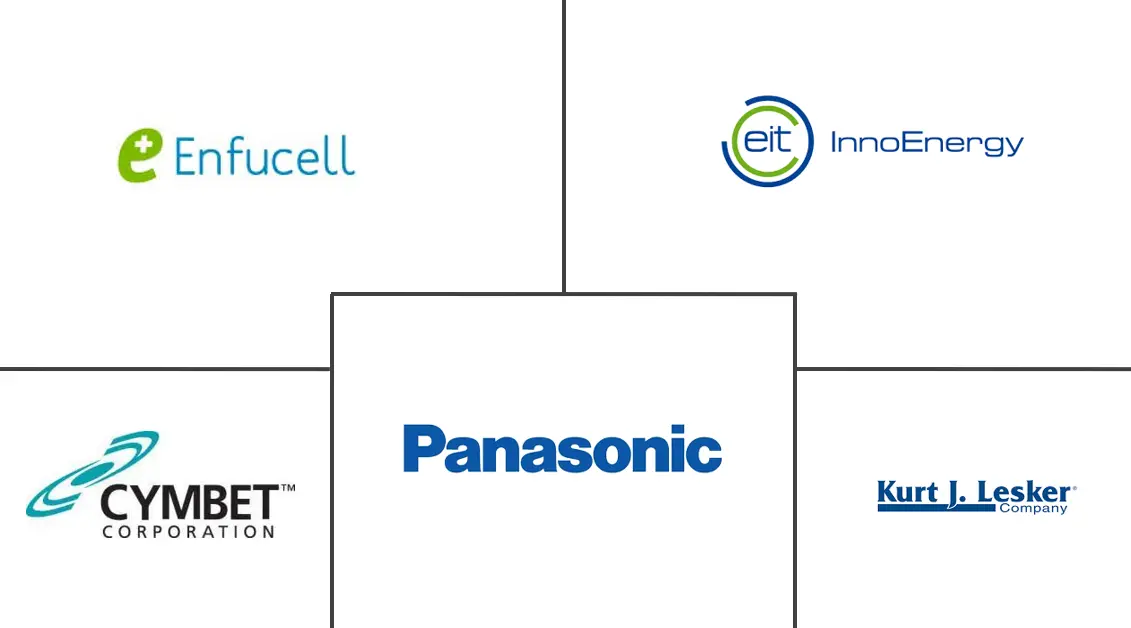Thin Film Battery Market Size and Share
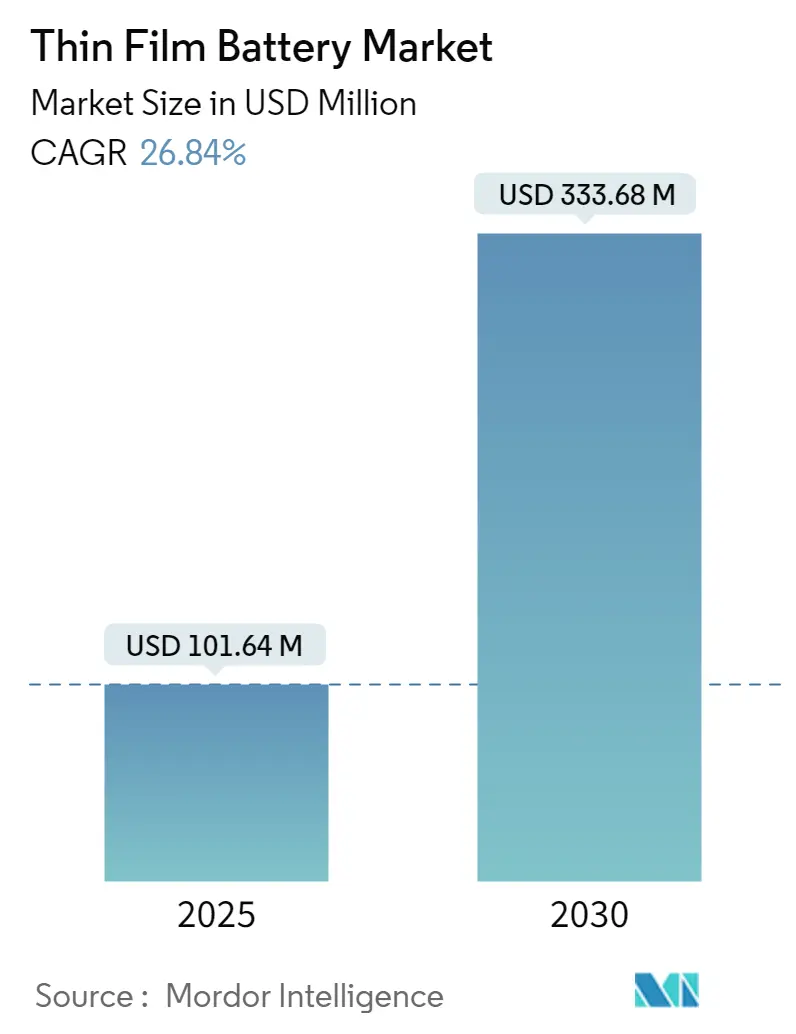
Thin Film Battery Market Analysis by Mordor Intelligence
The Thin Film Battery Market size is estimated at USD 101.64 million in 2025, and is expected to reach USD 333.68 million by 2030, at a CAGR of 26.84% during the forecast period (2025-2030).
The thin film battery industry is experiencing significant transformation driven by technological advancements and changing consumer preferences. The integration of these batteries into smart devices has accelerated, particularly evident in the wearable technology sector where global smartwatch sales recorded an 11% year-on-year growth in the second quarter of 2023. This surge in adoption is further supported by substantial investments in digital infrastructure, exemplified by Amazon Web Services' announcement in January 2024 to invest USD 15.5 billion in expanding its cloud presence in Japan, highlighting the growing demand for efficient power solutions in connected devices.
The industry has witnessed remarkable progress in manufacturing efficiency and cost optimization. Battery production costs have decreased significantly, with the average price reaching USD 139 per kWh in 2023, representing an 80% reduction compared to 2013 levels. This cost reduction has been accompanied by innovations in battery design and materials, with companies like Swiss startup BTRY securing CHF 900,000 in funding in January 2024 to develop ultra-fast charging thin-film solid-state batteries capable of one-minute charging and discharging cycles.
The thin film battery market is experiencing robust growth in emerging economies, particularly in the Asia-Pacific region. India's wearable market demonstrated exceptional growth, with the International Data Corporation (IDC) reporting a 34.2% increase to 134.2 million units in 2023, while the average selling price of wearables dropped by 15% to USD 21.2. This trend is complemented by significant government initiatives, such as India's September 2023 announcement of a INR 6,000 crore investment in pharmaceutical and medical device manufacturing sectors under the production-linked incentive scheme.
The industry is witnessing increased integration with e-commerce and digital payment systems, particularly in developing markets. Brazil's e-commerce sector demonstrated this trend with record-breaking sales of USD 575.7 million during Black Friday 2022, indicating growing demand for electronic devices powered by thin-film batteries. Additionally, countries are developing their raw material capabilities, as evidenced by Brazil's August 2023 announcement of a multi-sectoral program to exploit lithium resources in Vale do Jequitinhonha, positioning the country to support the growing demand for battery materials.
Global Thin Film Battery Market Trends and Insights
Growing Adoption of IoT Applications
The proliferation of IoT devices across various industries is driving significant demand for IoT battery solutions, particularly due to their compact size and high energy density characteristics. In January 2024, Amazon Web Services (AWS) announced a substantial investment of JPY 2.3 trillion (USD 15.5 billion) to expand its cloud presence in Japan, highlighting the growing infrastructure needs for IoT and AI applications. This type of large-scale investment in cloud infrastructure demonstrates the expanding ecosystem that requires reliable power sources for numerous connected devices and sensors. The integration of thin film battery technology in IoT applications enables remote monitoring, data collection, and control across diverse sectors, including smart cities, industrial automation, and environmental monitoring.
The versatility of thin film batteries in IoT applications is further enhanced by their ability to be paired with energy harvesting technologies, such as solar panels, thermoelectric generators, and kinetic energy harvesters. This combination creates self-sustaining IoT systems that can operate autonomously in remote or inaccessible locations, making them ideal for applications such as asset tracking and environmental sensing. The batteries' high cycle life and superior energy density compared to conventional battery technologies enable IoT devices to operate for extended periods without frequent battery replacements or recharges, significantly enhancing the reliability and efficiency of IoT deployments, especially in challenging environments where maintenance access may be limited.
Increasing Demand for Lightweight and Flexible Smaller Battery in Consumer Electronics
The consumer electronics sector is experiencing a transformative shift toward miniaturization and enhanced functionality, creating unprecedented demand for lightweight and flexible battery solutions. According to recent data, smartphone shipments have increased 5.7 times compared to 2009 levels, demonstrating the explosive growth in portable electronic devices that require efficient power sources. This trend extends beyond smartphones to include a wide range of devices such as smartwatches, fitness trackers, and wireless earbuds, all of which benefit from the compact and flexible nature of thin film batteries. In August 2023, a significant breakthrough was achieved when scientists from German and British universities developed T-Nb2O5 thin films, facilitating accelerated lithium-ion movement and promising enhanced battery performance for computing and lighting applications.
The evolution of consumer preferences towards devices with longer lifespans and sustainable energy solutions has further accelerated the adoption of wearable battery technologies. These batteries offer improved energy density and extended cycle life compared to traditional power sources, meeting the growing consumer demand for devices with prolonged usage periods and reduced environmental impact. The integration of thin film batteries into consumer electronics has been particularly revolutionary in the wearable technology segment, where form factor and weight considerations are crucial. For instance, according to IDC data, the Indian wearable market demonstrated remarkable growth with 134.2 million units in 2023, while the average selling price of wearables dropped by 15% to USD 21.2, indicating increasing accessibility and adoption of devices requiring efficient, compact power solutions.
Segment Analysis: By Battery Type
Rechargeable Segment in Thin Film Battery Market
The rechargeable segment dominates the global thin film battery market, commanding approximately 73% of the total market share in 2024. This significant market position is primarily driven by the increasing adoption of thin film rechargeable battery technologies in various applications, including consumer electronics, medical devices, and wearable technology. The segment's dominance is further strengthened by the growing demand for IoT devices and the increasing need for compact, lightweight power sources in smart devices. Rechargeable thin film batteries offer several advantages over other battery technologies, including flexibility, increased charging cycles, and potentially lower production costs. The segment is also witnessing substantial growth due to continuous innovation in battery technology coupled with the rising demand for batteries in consumer electronics and medical devices. The versatility of rechargeable thin film batteries in terms of shape and size enables seamless integration into various devices of different configurations, enhancing both functionality and visual appeal to end users.
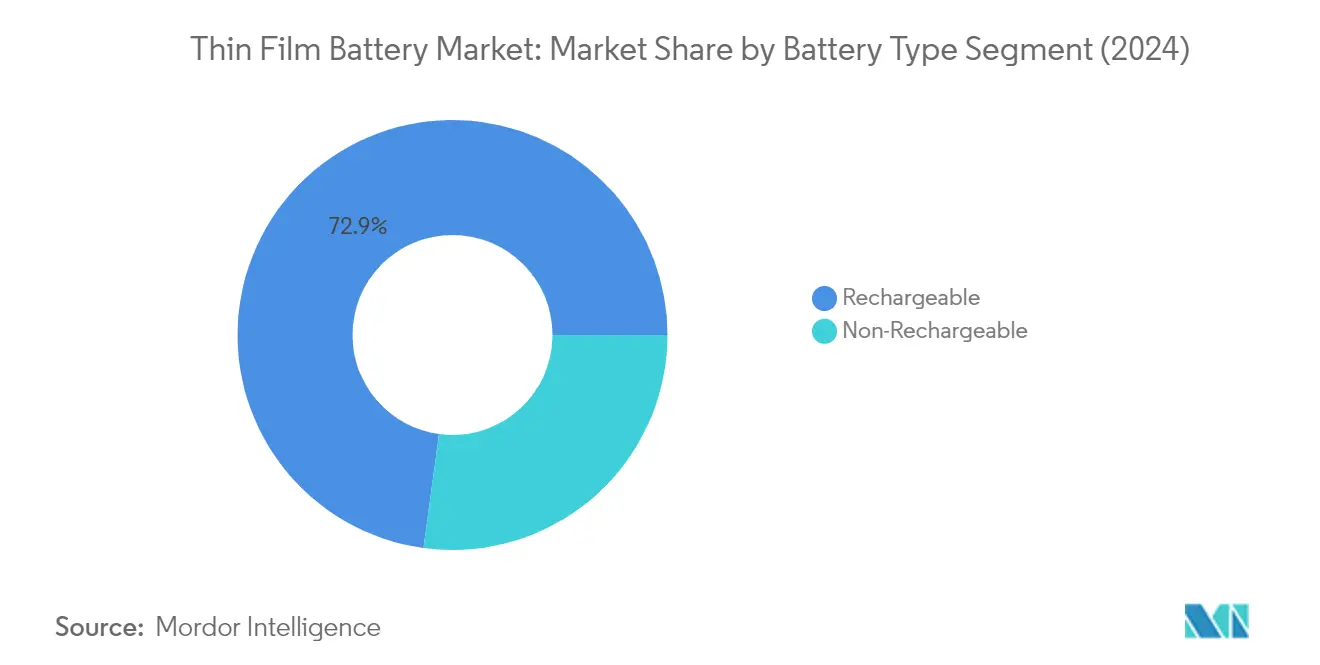
Non-Rechargeable Segment in Thin Film Battery Market
The non-rechargeable segment plays a crucial role in the thin film battery market, particularly in applications where single usage and consistent power delivery are essential requirements. These batteries are manufactured for single usage, providing reliable and consistent power throughout a predetermined lifespan. The segment finds significant applications in smart cards and RFID tags, where the batteries serve as a reliable power source enabling continuous operations and extended reading ranges. Non-rechargeable thin film batteries offer more efficient compact and lighter battery configurations compared to their rechargeable counterparts, making them an ideal option for applications where battery size is a critical factor. The segment's growth is further supported by the increasing adoption of smart cards in various sectors and the growing implementation of RFID technology in retail and supply chain management applications.
Segment Analysis: By Technology
Printed Battery Segment in Thin Film Battery Market
The printed battery segment dominates the thin film battery market, commanding approximately 80% of the total market share in 2024. This significant market position is attributed to the segment's superior advantages in manufacturing flexibility and cost-effectiveness through scalable production methods like roll-to-roll processing. The technology enables precise control over battery layer thickness and composition, allowing customization of performance characteristics such as voltage, capacity, and energy density. Printed batteries are particularly well-suited for integration into various electronic devices and applications due to their adaptability to curved shapes and ability to withstand mechanical deformation. The segment is experiencing robust growth and is projected to expand at nearly 22% annually from 2024 to 2029, driven by increasing adoption in wearable technology, IoT devices, and medical applications. The growth is further supported by ongoing research and development efforts focused on improving energy density, cycle life, and manufacturing efficiency.
Remaining Segments in Technology Segmentation
The ceramic battery segment represents the second-largest technology segment, offering unique advantages in high-temperature applications and enhanced electrochemical stability. These batteries utilize ceramic materials as solid electrolytes, providing superior thermal resistance and safety features particularly valuable in electric vehicle applications. The lithium polymer battery segment, while smaller, plays a crucial role in applications requiring high specific energy and lightweight design, such as mobile devices and portable electronics. These batteries feature polymer electrolytes that enable flexible form factors and improved safety compared to traditional liquid electrolytes. Both segments continue to evolve through technological advancements and expanding application areas, contributing to the overall growth of the thin film battery market.
Segment Analysis: By Application
Medical Devices Segment in Thin Film Battery Market
The medical devices segment has emerged as the dominant force in the thin film battery market, commanding approximately 54% of the total market share in 2024. This substantial market presence is driven by the increasing adoption of portable and implantable medical devices that require reliable, compact power sources. The segment's growth is particularly notable in applications such as defibrillators, pacemakers, cochlear implants, and spinal cord stimulators, where thin film batteries offer crucial advantages in terms of size, reliability, and safety. The aging global population and advancements in medical technology have been instrumental in driving this segment's dominance, with approximately 9.81% of the total world population aged 65 and above in 2024, creating a sustained demand for medical devices powered by thin film batteries.
Consumer Electronics Segment in Thin Film Battery Market
The consumer electronics segment is projected to exhibit the highest growth rate in the thin film battery market, with an expected CAGR of approximately 24% during the forecast period 2024-2029. This remarkable growth trajectory is fueled by the increasing miniaturization of electronic devices and the growing demand for compact, efficient power solutions. The segment's expansion is particularly driven by the development of advanced portable devices, including smartphones, wearables, and IoT devices, where thin film batteries' unique characteristics of flexibility, lightweight design, and improved energy density make them ideal power sources. Recent technological breakthroughs, such as the development of T-Nb2O5 thin-film batteries by German and British universities, have further accelerated the segment's growth potential by promoting faster lithium-ion movement and enhanced battery performance.
Remaining Segments in Thin Film Battery Market by Application
The thin film battery market encompasses several other significant segments including wearable technology, RFID, and smart cards, each serving unique application needs. The wearable technology segment is particularly noteworthy for its applications in fitness trackers, smartwatches, and health monitoring devices, where the compact and flexible nature of thin film batteries provides optimal power solutions. The RFID segment leverages these batteries for tracking and identification applications across various industries, while the smart card segment utilizes them for secure payment systems and identification cards. These segments collectively contribute to the market's diversity and demonstrate the versatility of thin film battery technology across different application domains.
Thin Film Battery Market Geography Segment Analysis
Thin Film Battery Market in North America
The North American thin film battery market demonstrates robust development across various applications, particularly in consumer electronics and medical devices. The United States leads the regional market with significant technological advancements and research initiatives, while Canada shows promising growth potential through increasing adoption in wearable technology and IoT applications. The region benefits from a strong presence of key market players and continuous innovation in battery technology manufacturing processes.
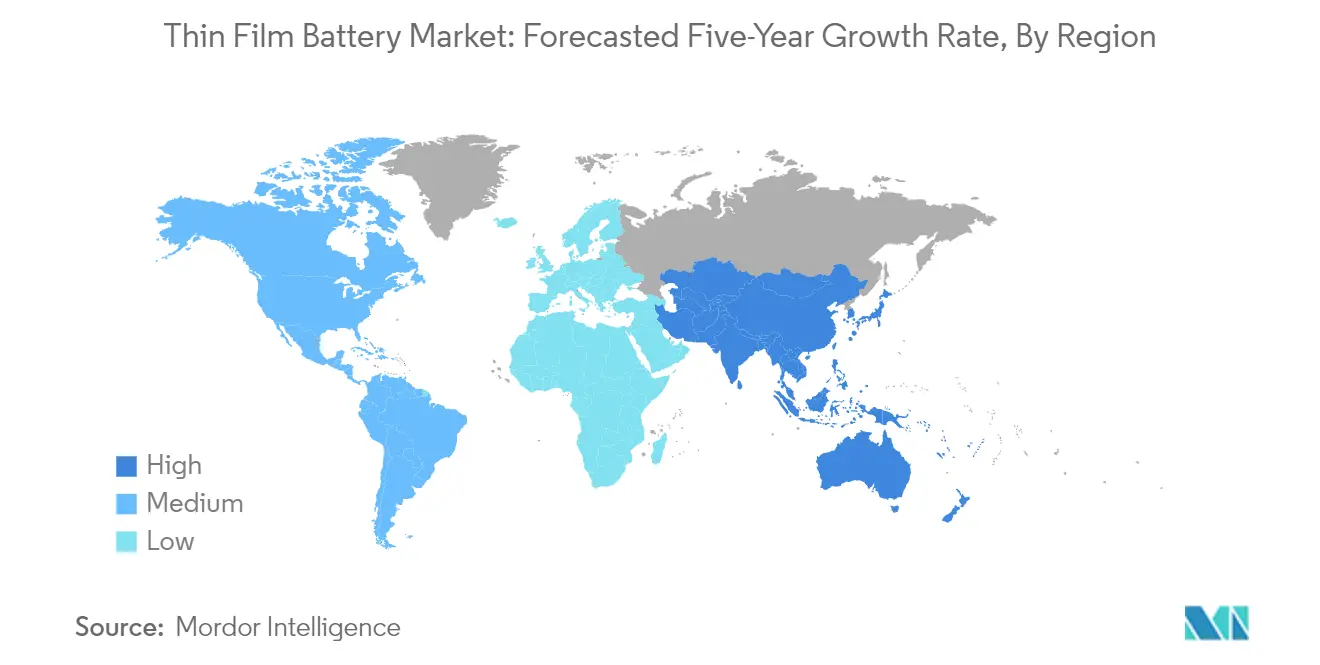
Thin Film Battery Market in the United States
The United States dominates the North American thin film battery landscape, holding approximately 90% of the regional market share in 2024. The country's market is driven by extensive research and development activities in battery technology, particularly in consumer electronics and healthcare sectors. The presence of major technology companies and increasing investments in IoT applications further strengthen the market position. The country's robust healthcare sector and growing adoption of medical devices create substantial opportunities for thin film battery applications. Additionally, the increasing focus on wearable technology and smart devices continues to drive market growth in the United States.
Thin Film Battery Market Growth Dynamics in the United States
The United States is also experiencing the highest growth rate in North America, with a projected CAGR of approximately 22% from 2024 to 2029. This growth is fueled by the increasing adoption of IoT devices, expanding applications in medical devices, and rising demand for consumer electronics. The country's strong focus on technological innovation and substantial investments in research and development contribute to this growth trajectory. The expansion of smart home applications and increasing integration of thin film batteries in various electronic devices further accelerate market development. The presence of a mature consumer electronics industry supported by high-tech connectivity infrastructure continues to drive market expansion.
Thin Film Battery Market in Europe
The European thin film battery market showcases significant diversity across its major economies, with varying levels of technological adoption and market maturity. Germany leads the market with strong industrial applications and technological innovations, while countries like France and the United Kingdom maintain substantial market presence through their advanced healthcare and consumer electronics sectors. The region benefits from strong research and development initiatives, particularly in countries like Germany and France, while emerging markets like Turkey and Russia show increasing adoption rates.
Thin Film Battery Market in Germany
Germany maintains its position as Europe's largest thin film battery market, commanding approximately 20% of the regional market share in 2024. The country's leadership is attributed to its strong industrial base and significant investments in renewable energy technologies. The presence of major automotive manufacturers and their increasing focus on electronic components creates substantial demand for thin film batteries. Germany's robust healthcare sector and growing adoption of medical devices further strengthen its market position. The country's emphasis on Industry 4.0 initiatives and smart manufacturing continues to drive market growth.
Thin Film Battery Market Growth Dynamics in Russia
Russia emerges as the fastest-growing market in Europe, with a projected CAGR of approximately 23% from 2024 to 2029. The country's market growth is driven by increasing investments in medical device manufacturing and growing adoption of consumer electronics. Russia's expanding healthcare sector and government initiatives to promote domestic manufacturing contribute significantly to market development. The country's focus on developing its technology sector and increasing adoption of IoT devices further accelerates market growth. Additionally, collaborations between domestic and international manufacturers create new opportunities for market expansion.
Thin Film Battery Market in Asia-Pacific
The Asia-Pacific region represents a dynamic market for thin film batteries, characterized by rapid technological adoption and diverse application areas. The region benefits from the presence of major manufacturing hubs and growing investments in electronic device production. Countries like China, Japan, and South Korea lead in technological innovations, while emerging economies like India and Indonesia show increasing adoption rates. The region's strong focus on consumer electronics and growing healthcare sector creates substantial opportunities for market expansion.
Thin Film Battery Market in China
China maintains its position as the dominant force in the Asia-Pacific thin film battery market. The country's leadership is driven by its extensive manufacturing capabilities and strong presence in the consumer electronics sector. China's robust supply chain infrastructure and growing investments in research and development contribute to its market dominance. The country's expanding healthcare sector and increasing adoption of wearable technology further strengthen its market position. Additionally, government initiatives supporting technological innovation and domestic manufacturing capabilities enhance market growth.
Thin Film Battery Market Growth Dynamics in China
China also leads the region's growth trajectory, demonstrating strong market expansion potential. The country's market growth is driven by increasing investments in electronic device manufacturing and rising demand for portable electronic devices. China's focus on developing advanced battery technologies and expanding applications in various sectors contributes to market development. The country's strong emphasis on renewable energy integration and smart device adoption further accelerates market growth. Additionally, the presence of major manufacturers and continuous technological innovations support market expansion.
Thin Film Battery Market in Middle East & Africa
The Middle East & Africa region presents an emerging market for thin film batteries, with varying levels of adoption across different countries. Saudi Arabia leads the regional market, while the United Arab Emirates shows promising growth potential. The region's market is primarily driven by increasing investments in consumer electronics and healthcare sectors, particularly in Gulf Cooperation Council countries. The growing adoption of smart devices and increasing focus on healthcare infrastructure development contribute to market growth, with Saudi Arabia emerging as both the largest and fastest-growing market in the region.
Thin Film Battery Market in South America
The South American thin film battery market demonstrates steady development, with Brazil emerging as both the largest and fastest-growing market in the region. The market is characterized by increasing adoption of consumer electronics and growing investments in healthcare infrastructure. Countries like Argentina and Colombia show gradual market development through rising demand for portable electronic devices. The region's focus on improving healthcare services and increasing adoption of wearable technology contributes to market growth, while Brazil's strong manufacturing base and growing consumer electronics sector drive regional market expansion.
Competitive Landscape
Top Companies in Thin Film Battery Market
The thin film battery companies market is led by established players like STMicroelectronics NV, Jiangsu Enfucell Flexible Electronics, Ilika PLC, and NGK Insulators Ltd, who are driving innovation through advanced manufacturing processes and material technologies. Companies are increasingly focusing on developing ultra-thin, flexible, and high-performance batteries to meet the growing demands of miniaturized electronic devices and IoT applications. Strategic collaborations with research institutions and technology companies are accelerating product development cycles and enabling access to new markets. Manufacturers are expanding their production capabilities through investments in state-of-the-art facilities while simultaneously working on improving battery efficiency, lifespan, and charging capabilities. The industry is witnessing a strong emphasis on sustainable manufacturing practices and environmentally friendly battery solutions, with companies investing in green technologies and recyclable materials.
Dynamic Market Structure Drives Industry Evolution
The thin film battery market exhibits a moderately consolidated structure, with a mix of global electronics conglomerates and specialized battery manufacturers competing for market share. Large multinational corporations leverage their extensive R&D capabilities and established distribution networks to maintain their competitive edge, while specialized players focus on niche applications and custom solutions. The market is characterized by strategic partnerships and joint ventures aimed at combining complementary strengths in technology development and market access. Regional players, particularly in Asia-Pacific, are gaining prominence through cost-effective manufacturing and strong local market understanding.
The industry has witnessed significant merger and acquisition activity, with larger companies acquiring innovative startups to expand their technological capabilities and product portfolios. Notable transactions include CCL Industries' acquisition of Imprint Energy and various strategic partnerships in advanced battery technology development. Market players are increasingly focusing on vertical integration to secure supply chains and maintain quality control. The competitive landscape is further shaped by the presence of research institutions and technology partners who contribute to product innovation and the development of next-generation battery solutions.
Innovation and Adaptability Drive Market Success
Success in the thin film battery market increasingly depends on companies' ability to innovate while maintaining cost competitiveness. Incumbent players must focus on continuous R&D investment, strategic partnerships with end-users, and the development of customized solutions for specific applications. Companies need to establish strong intellectual property portfolios while simultaneously building flexible manufacturing capabilities to address varying customer demands. The ability to scale production while maintaining quality and managing costs will be crucial for maintaining market position, particularly as demand from consumer electronics and IoT sectors continues to grow.
New entrants and challenger companies can gain market share by focusing on specialized applications and emerging market segments, particularly in medical devices and smart packaging. Building strong relationships with technology partners and end-users while developing innovative solutions for specific industry challenges will be crucial. Companies must also navigate potential regulatory changes, particularly regarding battery safety and environmental standards, while managing the risk of substitution from alternative energy storage technologies such as solid-state battery solutions. Success will increasingly depend on the ability to offer comprehensive solutions that combine product performance with sustainability features, while maintaining strong customer relationships and technical support capabilities.
Thin Film Battery Industry Leaders
-
Enfucell OY Ltd.
-
Enfucell OY Ltd.
-
Cymbet Corporation, Inc.
-
Kurt J. Lesker Company
-
Panasonic Corporation
- *Disclaimer: Major Players sorted in no particular order
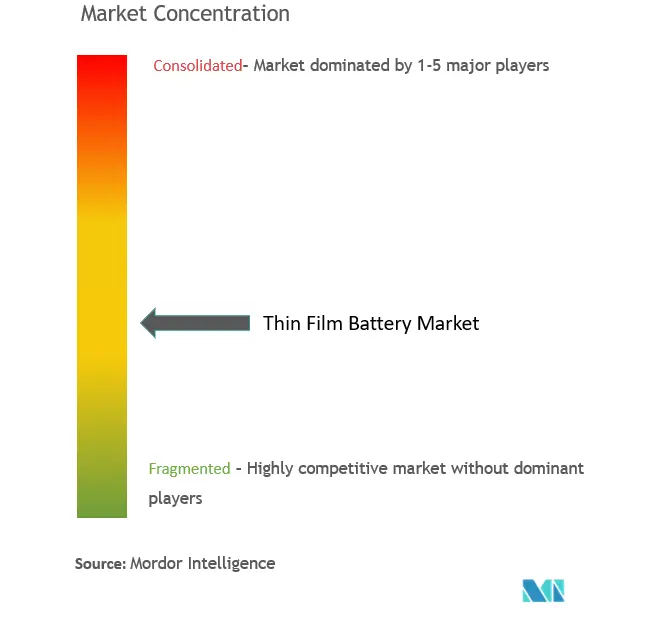
Recent Industry Developments
- February 2024: LionVolt, a Dutch startup, started developing 3D solid-state batteries made up of a thin film containing billions of solid pillars, creating a patented 3D architecture with a large surface area. The company also raised EUR 15 million (USD 16 million) to scale up the production of these batteries.
- January 2024: Battery start-up BTRY raised CHF 900,000 in pre-seed financing to develop safe, long-lasting thin-film solid-state batteries that can be charged and discharged in one minute. The company has developed thin-film cells, which are only a few micrometers thick, into more powerful batteries. It has also developed a process that uses high-precision vacuum coating and no toxic solvents.
Global Thin Film Battery Market Report Scope
Thin film batteries are a type of energy storage device that is characterized by their light and flexible nature. They are made using thin layers of various materials deposited on a substrate, usually through a process called physical vapor deposition or chemical vapor deposition. These batteries typically use solid-state technology and offer advantages such as flexibility, small form factors, and the ability to be integrated into various devices and applications.
The thin film battery market is segmented by battery type, technology, application, and geography (North America, Europe, Asia-pacific, Europe, South America, And the Middle East and Africa). By battery type, the market is segmented into rechargeable and non-rechargeable. By technology, the market is segmented into printed batteries, ceramic batteries, lithium polymer batteries, and other technologies. By application, the market is segmented into consumer electronics, medical devices, wearable technology, smart card, RFID, and other applications. The report also covers the market size and forecasts for the thin film battery market across major regions.
For each segment, the market sizing and forecasts have been done based on revenue (USD).
Key Questions Answered in the Report
How big is the Thin Film Battery Market?
The Thin Film Battery Market size is expected to reach USD 101.64 million in 2025 and grow at a CAGR of 26.84% to reach USD 333.68 million by 2030.
What is the current Thin Film Battery Market size?
In 2025, the Thin Film Battery Market size is expected to reach USD 101.64 million.
Who are the key players in Thin Film Battery Market?
Enfucell OY Ltd., Enfucell OY Ltd., Cymbet Corporation, Inc., Kurt J. Lesker Company and Panasonic Corporation are the major companies operating in the Thin Film Battery Market.
Which is the fastest growing region in Thin Film Battery Market?
Asia Pacific is estimated to grow at the highest CAGR over the forecast period (2025-2030).
Which region has the biggest share in Thin Film Battery Market?
In 2025, the North America accounts for the largest market share in Thin Film Battery Market.
What years does this Thin Film Battery Market cover, and what was the market size in 2024?
In 2024, the Thin Film Battery Market size was estimated at USD 74.36 million. The report covers the Thin Film Battery Market historical market size for years: 2019, 2020, 2021, 2022, 2023 and 2024. The report also forecasts the Thin Film Battery Market size for years: 2025, 2026, 2027, 2028, 2029 and 2030.
Page last updated on:
